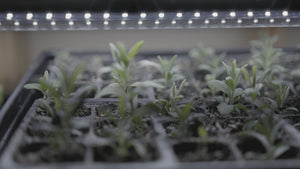Topics
How to Grow Beet Microgreens: A Deliciously Different Superfood
Microgreen growing tipsThe vibrant magenta stems and bright green leaves of beet microgreens are more than just a wonderful garnish. Their sweet earthy flavor is also a rich source of vitamin C, carotene, and lutein. Not sure you like beets? Try these microgreens and get an extra dose of nutrition.

How to Grow Beet Microgreens
- Soak beet seeds in a bowl of water for 4-8 hours.
- Spread the seeds onto a damp growing medium.
- Cover the seeds and keep them away from light for 6 - 8 days.
- This is the blackout period referred to on the seed packet.
- Keep the seeds moist by misting them with water from a spray bottle.
- Maintain an average room temperature.
- Check daily and mist as needed to keep them moist.
- Once the beet seeds have sprouted, remove the cover and expose the seedlings to direct light.
- The light during this growth period is essential for beet microgreens. The bright green and red colors develop during the photosynthesis process. While these colors are beautiful, they are also very nutritious.
- Continue keeping the seeds moist until they’re ready to harvest.
When and How to Harvest Beet Microgreens
Beet microgreens will be ready to harvest in 11-21 days. They will be about 2 inches tall, with the seed leaves (cotyledons) fully grown.
You can choose to harvest now or wait a little longer for the first set of true leaves to appear.
Use scissors to cut the greens just above the soil.
The hulls of the beet seeds sometimes stay on and will need to be picked off by hand.
Rinse in cool water if needed.
Use immediately or place in the fridge and consume within a few days.
Enjoying Your Fresh Beet Microgreens
Colorful beet microgreens add beautiful visual interest as well as nutritional benefits.
Their deep red color can “bleed” into the food when crushed.
Try beet microgreens in salads, smoothies, and pesto for a fresh burst of nutrition.
Sprinkle them on pizza, sandwiches, baked potatoes, eggs, grain bowls, and cooked vegetables to add color and texture.
What are the nutritional benefits of Beet Microgreens?
The compact size of beet microgreens produces higher concentrations of vitamin C, E, and K than the same plants in their mature stage. In addition, carotenoids in the bright green cotyledons are turned into vitamin A in the body. These immature leaves also contain higher levels of lutein which can aid in prevention of macular degeneration and cataracts.
Eating beet microgreens is like getting all the nutrition of beets and beet greens in one small handful. The flavor is a similar earthy flavor to mature beets. But with beet sprouts, you can enjoy the extra nutrition any time of year and without cooking.
Start growing beet microgreens or beet sprouts indoors and see how easy it is to add an extra healthy serving to any meal.






Leave a comment